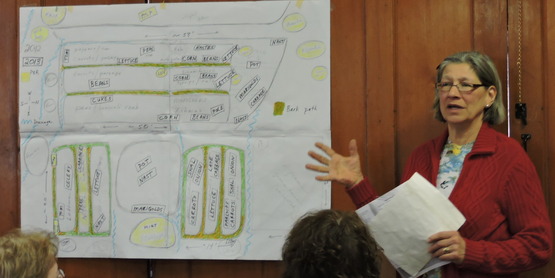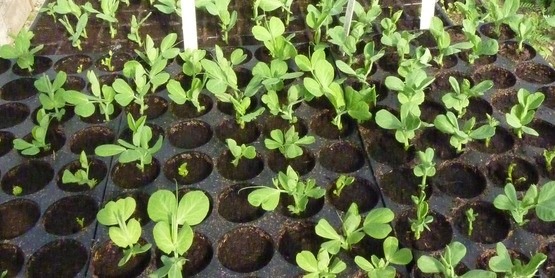By Debbie Bigelow, Cornell Cooperative Extension Allegany County Master Gardener

It happens every spring: just enough warmth to entice us into the outdoors, but still ‘way too cold to plant. The only things growing are the weeds and grasses. By the time we warm up and dry out enough to work in our gardens, the quackgrass, galinsoga, chickweed, mint, Gill-over-the-ground or whatever you are plagued with have taken over, especially at the edges of your beds. What to do?
- Don’t panic, even if you have no physical capability to tackle any weeding chores. Keep in mind that weeds are the “guardians of the soil”* – they cover bare spots (Nature abhors a vacuum) in order to keep the soil microorganisms fed and watered. They scavenge nutrients needed by successor plants, reduce erosion by water and wind, and build organic matter. They are aggressive because their reproductive cycles are generally very short. So while you are awaiting better or drier weather, they are doing you a service.
- Recognize that some weeds are more problematic than others. For instance, quackgrass, with its long, fibrous rhizomes (a modified underground stem) that tunnel every-which-way actually competes with other plants by exuding allelopathic (growth-inhibiting) compounds. Perennial weeds like burdock are very deep rooted and difficult to remove. Annual grass that creeps into the side of beds from the surrounding lawn is easier to uproot and remove. Identifying and understanding the weeds you have can be very helpful and there are numerous websites with pictures online.
- Decide how much soil disturbance you are willing to tolerate in order to be able to grow what you want. Are you putting transplants in, or do you need open soil space to plant seeds? If you need “clean” space, you’ll have to get rid of more grass and weeds than if you merely need a large enough planting hole opened up to get your transplants off to a strong start.
- Is it critical to have a “neat” looking garden,or can you be content with a good place to grow your food or flowers that is not going to win any House Beautiful photo contests? The plants truly don’t care. They just want enough space, nutrients, water and sun to do their thing. And if you disturb your soil as minimally as possible, you leave it healthier, which pays off long-term.

- Rototilling the weedy area seems like a solution as soon as it’s done, because the area now looks like a “clean slate” for your planting activity. However, repeated tilling not only destroys soil structure, making it less permeable to rain infiltration and likely to erode, it is also catastrophic for the soil microbes that would work for you if you give them the environment they need. It brings new weed seeds to the surface where they can get light and germinate, causing more headaches, and multiplies the perennial weeds by cutting their roots into little pieces which germinate and make new weeds. Tillage is increasingly recognized as a destructive procedure (the “no till” movement). If you do it, resolve to do it only once, and to restore and maintain your soil using natural processes from now on.
- If you can’t physically dig out weeds, or pull them out, consider putting this season on “pause” for that overgrown garden bed, and renovate it instead using the “lasagna gardening” method. Layer cardboard (the less printing, the better) or several sheets of black and white newsprint over the weedy space, water it until soaking wet, then cover with at least a foot of compostable materials: animal manure mixed with bedding (horse is best, if you can get it), grass clippings, fallen leaves (partly decomposed is great), vegetable scraps from the kitchen, coffee grounds, etc. Build as if you were making a new compost pile. Plant elsewhere (containers!) until next spring. The weedy bed you hesitated to tackle this year will be a nicely decomposed brand new planting space. No need to turn it or disturb it in any way – you can keep adding to it for a time if you want, but by late summer this year, cover the entire mound with dry leaves and just wait. Next year, you may see a few stubborn weeds making their way through the layers. Pull or cut what you can and mulch heavily to delay their return.
- Going forward, resolve to mulch more, and more deeply, and to maintain the mulch layer until it’s covered with snow. This is your best defense against cool-season grasses and weeds getting too far ahead of you over the winter and into early spring.
- During the coming summer, cut or mow weeds on the edges of your garden beds before they set seed which will blow into the garden and cause trouble. A thick mulch layer defends against this wind-blown weed multiplication by preventing seed-soil contact or by depriving germinating weed seeds of light and possibly moisture.
We’re here to help! In Allegany County, call or Email your Cornell Cooperative Extension Master Gardeners at 585-268-7644 ext. 23, or Email to alleganymg@cornell.edu. In Cattaraugus County call (716) 699-2377, or Email to cattaraugusmg@cornell.edu




